The Hemp Road Trip explores Colombia’s illicit hemp industry as the country moves towards legalization, traveling through bustling cities and up dangerous mountain roads to experience a vision of hemp where food is medicine.
Story and Photos By Rick Trojan
Originally published in Issue 4 of HEMP. Subscribe HERE or find in a local grocery store.
With a beneficial climate and plenty of agrarian land, Colombia has the potential to become a worldwide leader in producing hemp. Legal hurdles — along with complicated realities on the ground — still stand in the way. But as Colombia moves forward from its complicated past, new opportunities abound. This spring, I set out on another leg of my years-long Hemp Road Trip to find out where the Colombian hemp and cannabis industries are headed.
Legal Status of Cáñamo & Cannabis
Even though Colombia is historically known for the landrace sativa strain “Colombian Gold,” cannabis remains illegal for public consumption and cultivation. However, in 2012, the Colombian government decriminalized possession of up to 20 grams and personal cultivation up to 20 plants.
On the low-THC side, plants called cáñamo (industrial hemp), are not fully legal for cultivation. The word on the street was that the government expects this to change in the summer of 2018, but for now, only hemp research is authorized.
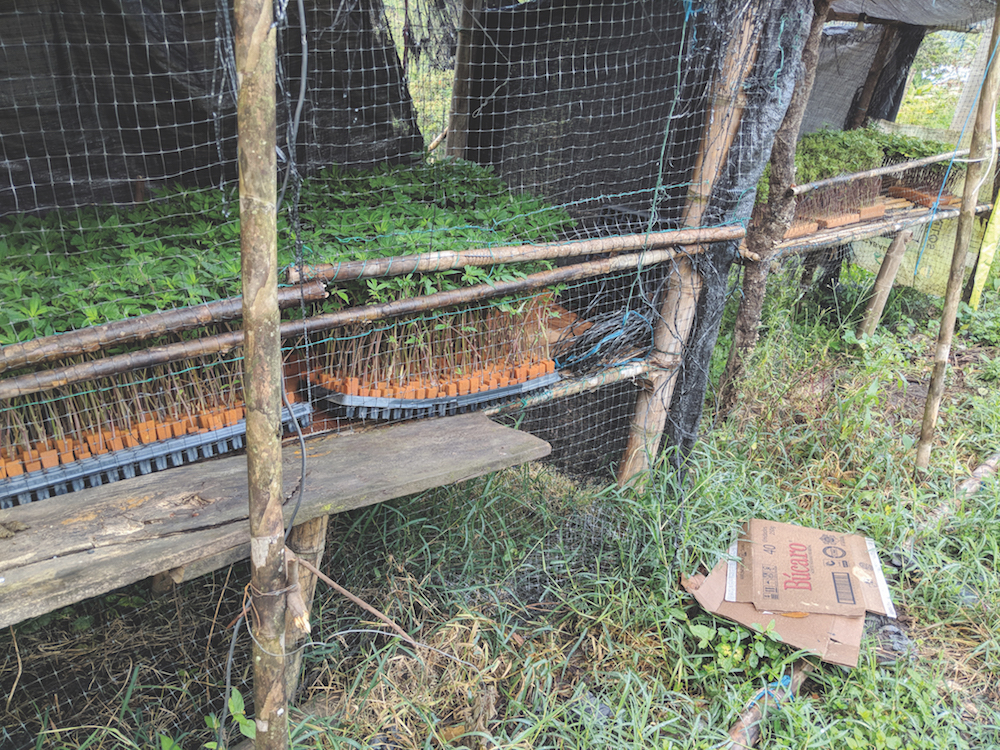
Clones of high-THC strains grow in substrate in the Colombian mountains.
I set out to get a better understanding of this country and help where I could with the expansion of cáñamo and cannabis. The tour would take me completely across the country (over 6,400 miles). We travelled from Cartagena to Montería, through Medellín to Silvia in guerilla territory, up to the capital of Bogotá, and then finally returned to Cartagena. We would often drive overnight, then tour farms, fish hatcheries, and businesses, speaking with locals who were interested in cáñamo and cannabis.
Bienvenidos a Colombia
We started in Cartagena, a beautiful, historic city with stunning colonial architecture and international flare. It’s home to one of the busiest ports in Colombia, and rife with opportunity, as well as crime. In Colombia, cash is king — I spent more cash in Colombia in two weeks than I spent at a high-end resort in the Hawaii Islands. That’s a small price to pay for organic food and security against cartel violence.
We then moved on to Montería, the beautiful capital city of the Department of Córdoba at the center of organic farming and distribution. It was there I first walked on organic land that reminded me of Neil Armstrong walking on the moon — sponge-like, trampoline-esque, bouncy soil.
After Montería, we attempted to drive to the infamous city of Medellin, but in true road trip fashion, our vehicle died in the middle of nowhere, between two of the three massive mountain ranges we needed to cross.
It wouldn’t be a proper Hemp Road Trip without some vehicle trouble. As we were driving overnight through the second steep mountain range, the vehicle suddenly started to overheat. We tried a couple of times to let it cool down in the crisp, chilly mountain night. It would cool, we’d get back on the road, and 1–2 miles later the vehicle would overheat and force us to pull over.
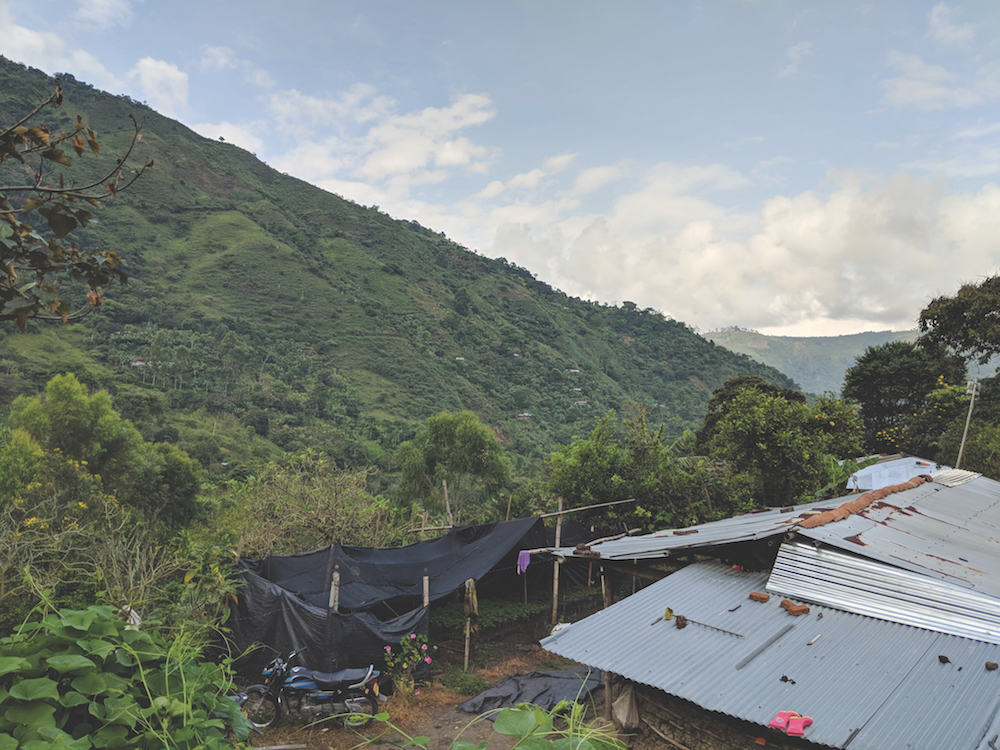
Cannnabis and hemp are grown in secret up in Colombia’s mountains, where motorcycles are the primary source of transportation.
Once, 15 miles from the nearest town, we had to pull our vehicle over on the side of the road, right after a downward turn, in an incredibly precarious situation. Tractor-trailers occasionally tore down the windy mountain roads at insane speeds, only slowing to narrowly pass the trucks going up the slope. On the positive side, the stars and natural setting, seen without light pollution, were incredible.
With no tools and no help for miles, we decided to push it and keep driving and pulling over until we ended up at a mountainside midnight café. As it turns out, a bus was headed to Santander de Quilichao, where we were to meet our guides and protectors the next day.
After some discussion, we agreed to abandon our broken vehicle and take tour buses for the remainder of our journey. Arturo, my guide, would return later to retrieve his vehicle. As it turned out, the busses would be a blessing in disguise, as both Arturo and I would not have to drive, and could get some sleep on overnight journeys.
We hopped on the bus bound for Santander de Quilichao, where we would meet the locals for transport — and protection — and head into jungle mountains never conquered by the Spanish or the Colombian governments, inhabited by peoples that still speak indigenous languages along with Castellano Spanish.
Heading to Guerrilla Territory
Our first stop was the mountain town of Silva, where about 37,000 people who speak four languages — Nam Trik, Misak, Castellano, and Nasa Yuwe — live at an elevation of 2,800 meters. Silvia rests in the Cauca region, much of which is under the de facto control of the FARC. Formed in 1964 as the military wing of the Colombian Communist Party, FARC was the largest of Colombia’s rebel groups, estimated to possess some 10,000 armed soldiers and many more supporters.
As a Marxist organization, FARC supports the redistribution of wealth and opposes the influence that multinational corporations and foreign governments (particularly the United States) have had on Colombia. Until recently, they used hijackings, bombings, kidnappings, and narcotrafficking to financially support themselves and destabilize the Colombian government.
The people in Cauca live under the control of the FARC, who have historically taken the locally grown cannabis, coca, opium, and other plants to market internationally to fund their activities against the Colombian government.
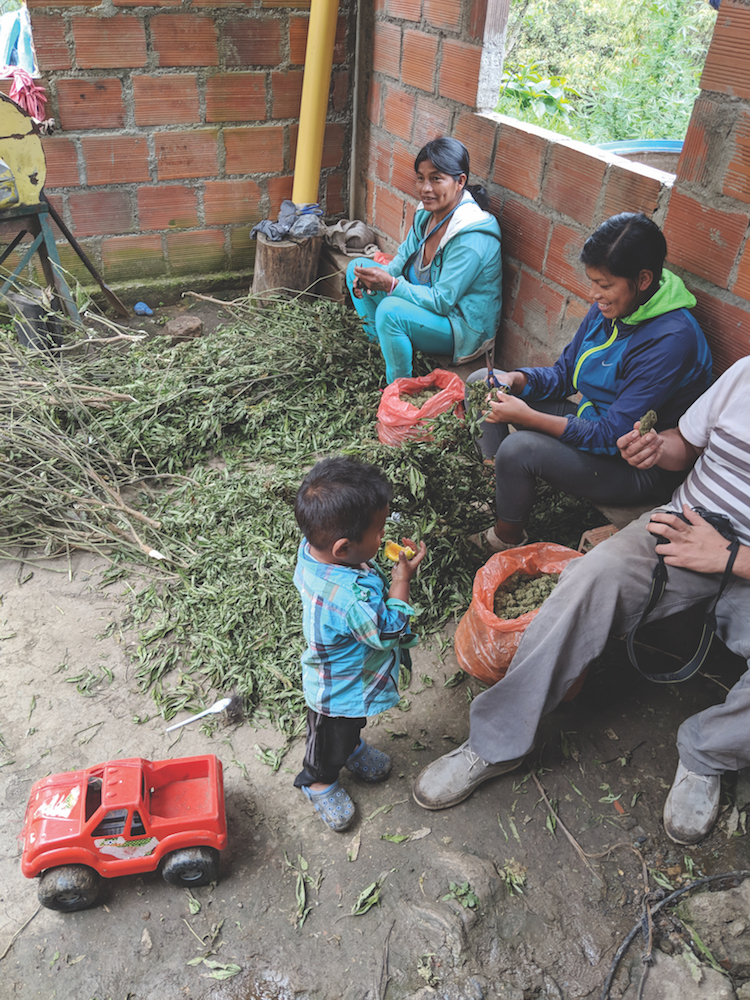
Three generals are present to process hand-cured and hand-crafted cannabis in the mountains of Colombia.
In fact, three years earlier, as a village I was visiting was hiding out from the guerilla faction violence, helicopters flew overhead and shot through the roof of the local high school, killing three people. They look back at this day as a long distant past, and hopefully, as something that will torment them no longer.
In August 2017, they negotiated a historic ceasefire with the Colombian government, and gained official recognition as a political party in exchange for ending an armed struggle that had killed thousands of Colombians on both sides. Currently, they are allocated 10 seats in the Colombian legislature, five in the House, and five in the Senate.
Despite the ceasefire, the Cauca area is not keen on outsiders, and remains controlled by FARC hierarchy. In order to enter this area as an outsider gringo, I needed help from local people to protect me from potential theft, kidnapping, or murder. Thankfully, my guide was able to setup the connections required to remain alive, photograph, and report back.
My accommodation consisted of a couple of small rooms, about 8 ft. by 8 ft., with walls made of bamboo rods and adobe mud. The kitchen was a similar size dwelling, with an electric stove and fire pit used to make some of the most delicious coffee I’ve ever tasted.
Lucky for me, our local hosts were celebrating a quinceañera — or 15th birthday — of a local girl named Luisa. Here I was in the middle of the Colombian jungle, in the highest mountains in all the land, surrounded by guerillas growing cannabis, coca, and opium (amongst other medicinal herbs), celebrating a fifteen-year-old’s birthday. We enjoyed local cake and sang songs, and I celebrated by dancing with her 83-year-old grandmother, who could shoulder-roll like a pro!
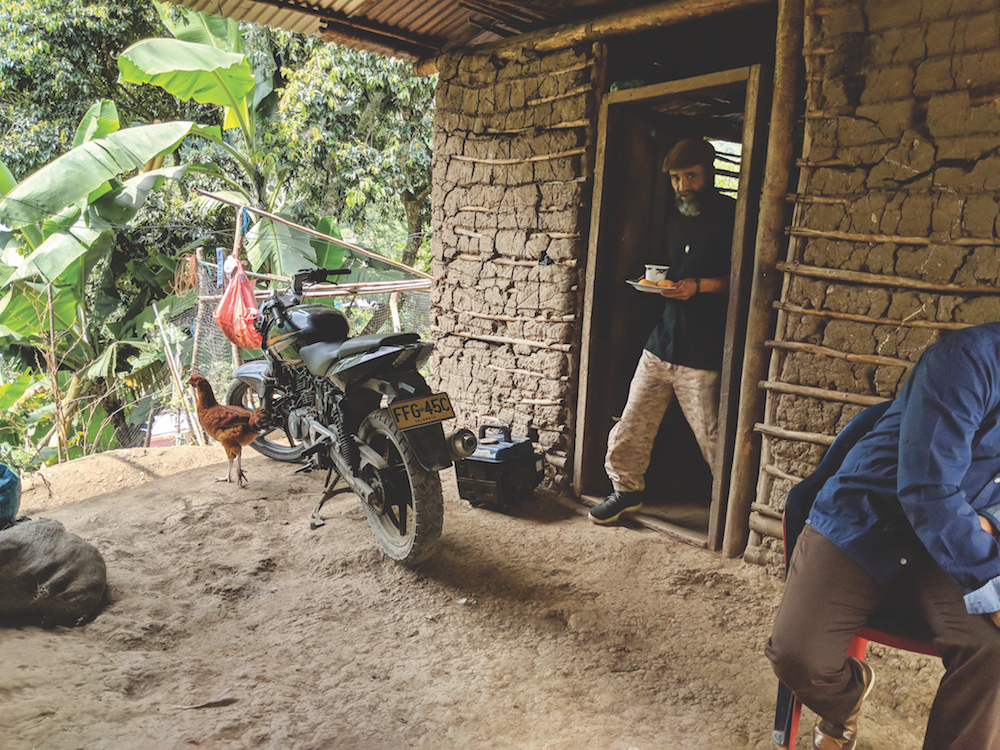
Javier comes out of a local kitchen constructed from bamboo and adobe mud. Structures like this could be made from hempcrete in the future.
My guide introduced me to Javier, who grows cannabis under incandescent lights on the steep mountainsides surrounding the village. We did our standard introduction, “Rick, the expert in cáñamo from the U.S., not cannabis, but the industrial side of the plant.” It was a similar introduction across the country.
Javier was using the terpenes from the cannabis plant in a very unique operation. He bottled up the distilled terpenes and was using them as a cleaning product for his home and cultivation facility. This was news to me: cannabis’s many applications also include utilizing it as a cleaning supply.
It was a pivotal moment in my understanding of that culture and the helped bring new light to this incredible plant. This plant not only adapts to its local soil, altitude, and rain conditions, it also adapts to provide the local people what they need, as a cleaning supply, nutritional supplement, healthy food, or natural medicine. I tour the world explaining the amazingness of this plant, and I fully realized, at this moment, the true meaning of that adaptability.
Hemp Has Answers!
Just after this realization, as if the universe needed to imprint this idea in my brain like a Texas rancher branding calves, a lightning strike hit. The thunderclap was loud enough to scare everyone in our group, and it took out the local power, leaving everything dark. There I was, without power underneath the starlit sky, needing to find my way back to my adobe accommodation in the jungle.
Typically, a situation without light in the middle of guerilla territory in Colombia would freak me out. However, I walked home alone, without light, direction, or guidance, and completely without trepidation. I realized during my walk home that this plant is so much more powerful, and has so much more potential, than I ever gave it credit for. It was my “aha” moment for cannabis.
The next day, I was blessed with a tour of the local mountains and landscape, where I held cáñamo stalks nearly half a foot in diameter from plants over 14 feet high. We ate off-the-plant coca seeds and leaves and drank cannabis juice. This lifestyle is so engrained in the lives of locals that I stumbled upon a full-length soccer field in the middle of the cáñamo jungle, which provides everything the young players need for nutrition, recovery, and motivation.
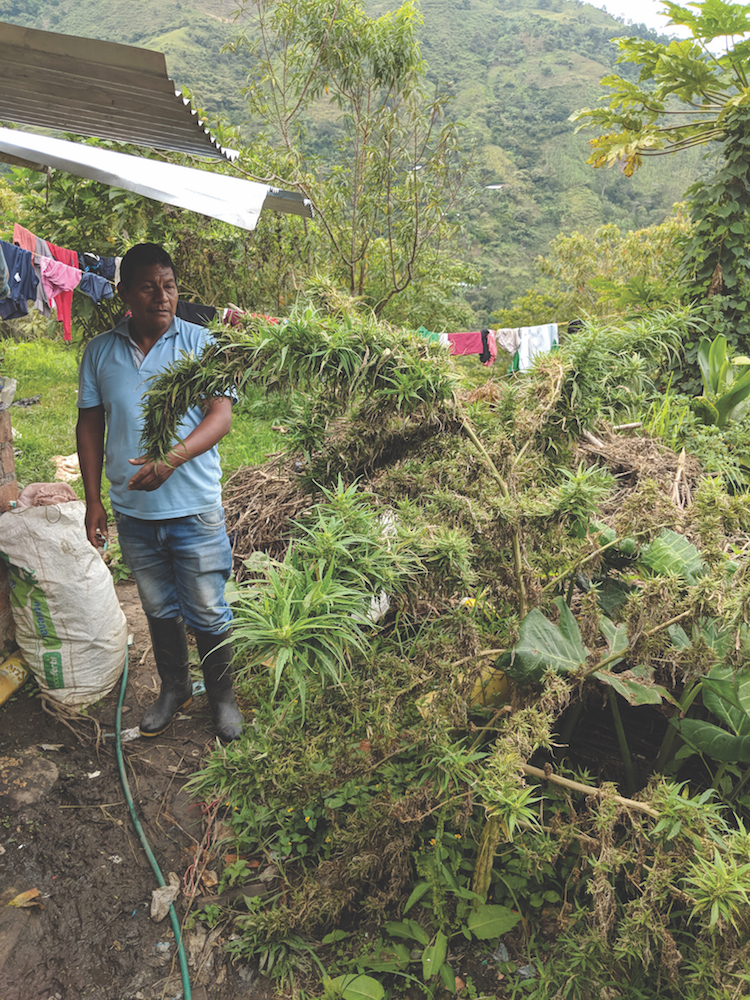
Cannabis plants in Colombia grow tall and free in a garden.
In fact, as it was explained to me at the Indio Center for Medicinal Plants and Herbs, the locals consider food as medicine. The children are taught, from a young age, how to cultivate medicine — or as we call it in the U.S. — food. They are taught to recognize and cultivate medicinal herbs from the land that will help grandma feel better or sustain mother during pregnancy. There is even a local fishery that utilizes fresh mountain spring water, combined with quinoa and medicinal herbs, to feed their fish.
I usually don’t choose to eat fish, especially when it has bright orange skin and includes the bones and head on the plate. However, there was so much nutrition in this fish that my body overrode my mind’s aversion and I ate the flesh, the skin, the bones, the everything — except for the head. It was absolutely delicious and amazingly nutritious, and like everything I ate in Colombia, it was organic and right from the earth.
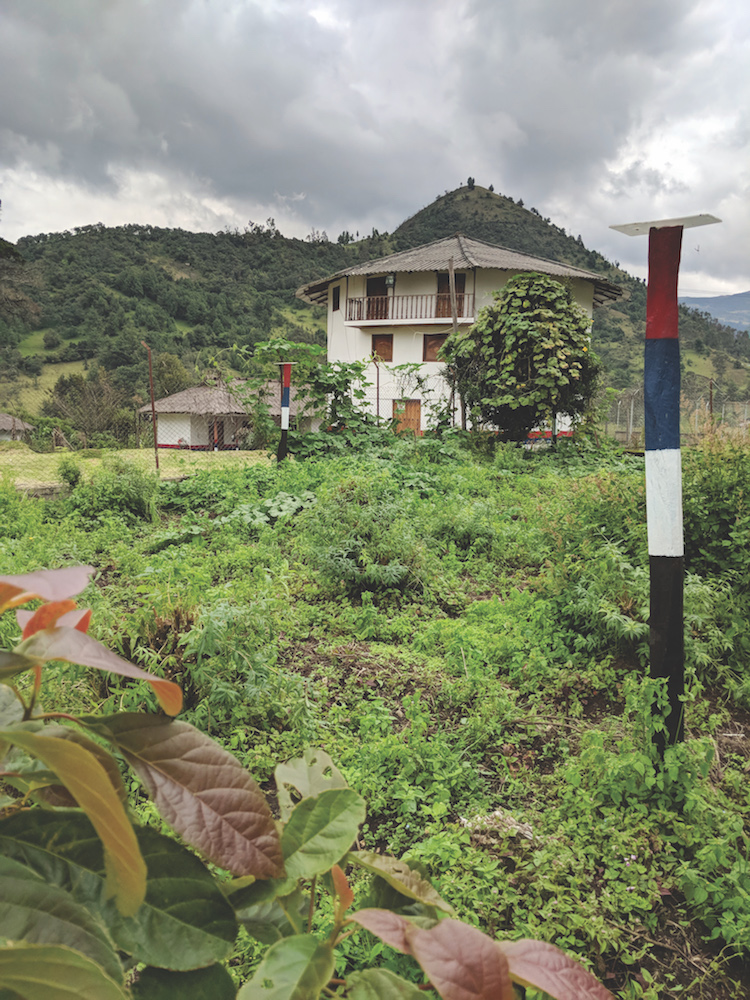
A training garden grows outside of Colombia’s Institute of Medicinal Plants.
Onward, Towards the City
From the adobe dwellings of Toribio and Silvia in the Cauca region, we headed down the mountains towards Bogotá. This sounds simple, but after a hellacious lightning storm and downpour, some of the roads were simply washed out on the steep slopes of the Northern Andes.
We were cramped in a Toyota truck, with five persons in a four-seat vehicle, moving slowly down the muddy roads, trying not to end up high-centered between deep tire tracks. Meanwhile, the locals were packed on a large school bus, bearing up the mountain as if there was not a deadly cliff drop to their left.
After miles of white-knuckling it down from the mountains, we finally reached a small town and transferred to an overnight bus headed to Bogotá.
Bogotá, the capital of Colombia, is a very metropolitan city with over 10 million residents, and up to 4 million additional migrant workers at any given time. I had the opportunity to meet with local business incubators and actually teach a class in Spanish to entrepreneurs and farmers. As they began to learn that cannabis is much more than something to smoke or eat, they became excited and very engaged.
Questions ranged from cannabis as a food to using it as an energy source, and even as a bioaccumulator that can help as a rotational crop for future yields. We talked about cultivation, processing, marketing, and distribution — under the constructs of the Colombian law — which currently does not allow nationwide cultivation.
My hope, and the hope of my students, is that Colombia will soon see a legal hemp industry, so that the Colombian people can enjoy the benefits of domestic use and cultivation — and can bring their hemp medicine down from the mountains and into the full sun of legalization.

